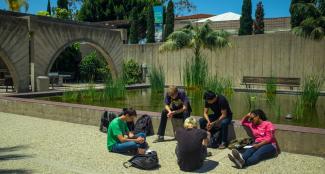3 Ways Prayer-Walking Changes Our Prayers for Campus

I’ll never forget that first time, as a college student, leaving the comfort of Mills Hall corner to walk around the Indiana State University (ISU) campus and pray in various locations. We were at the first stop of our prayer walk for less than five minutes, and I just couldn’t help myself—I opened my eyes to peek at my friends around the circle. Everyone was clearly more holy than me because all their eyes were closed—except for one friend, whose eyes were wide open. He was even making eye contact with people walking by, nodding and smiling at them, all while praying away. (Was that even allowed?!?)
I’ll be honest: as we stood in front of different academic buildings, praying for professors who taught there and classrooms we frequented, it felt a little weird. We stood in a cluster in our Student Union and prayed out loud with people looking on, wondering what we were doing. And some of our friends even saw us walking around talking to ourselves! It didn’t feel comfortable.
But since that first time, my prayers have been changed.
In her fantastic book, Spiritual Disciplines Handbook, Adele Ahlberg Calhoun writes, “Prayer walking can be a wonderful gift for those who like to get up and move around. This type of intercession intentionally invites people to go to the site of the concern: the office, the conference room, the dining room, the kitchen, the school, the hospital, the government buildings.”
Prayer-walking really is as simple as it sounds. You walk to a spot. You pray. And in my experience, simply trusting that God will meet me as I physically pray where I am has increased my passion for what I’m praying about and even surprised me by the opportunities it has created or prayer points that stir in my spirit.
I’ve had the privilege of supervising and leading an InterVarsity staff team for the past 18 months, and prayer-walking has been a real gift for us, especially as we consider the 2030 Calling that InterVarsity rolled out recently. One day, we met at a local coffee shop and then started walking toward the neighborhood in our city where many fraternity houses are situated (while my four-year-old happily ran around us chattering away, and my one-year-old munched on Cheerios in his stroller). A first-year Greek staff on our team gave us a quick rundown of every fraternity we passed, and we paused for a few minutes several times to pray over every chapter in eyesight.
Throughout the fall semester, we visited each of the three campuses in our city to pray over “corners” of campus where we don’t have much ministry or outreach happening. McKenzie Barber, a staff colleague of mine, reminded me that prayer-walking in places like this “allows us to pray over faces, names, and communities that we normally would not put ourselves in. It makes these corners of campus come alive and makes them more real.”
She’s right. For example, I already knew that our ISU faculty advisor, Ryan, is great. And yet something clicked in my spirit when I pulled out the text he’d sent me and we actually prayed for him and other faculty while standing outside of his office. Similarly, I know “The Towers” dorms at ISU hold over 1,500 students—I lived in one of them for four years!—but it was powerful for me to watch the dozens and dozens of students walking around those buildings while we prayed for Jesus’ name to resound through those hallways.
Most recently, our Terre Haute team has been praying for five campuses in Indianapolis that have become a part of our Mid-Indiana area. Having recognized the geographic challenge of prayer-walking campuses that are 90 minutes or more away from us, we’ve pulled up the campus maps of the schools in our weekly prayer time and prayed over the buildings, green spaces, and residence halls we see on our phones. This has been a great start, and these prayers will of course be heard and used by the Lord. But then in mid-January, I had the privilege of cohosting a prayer walk on one of these Indianapolis campuses with three volunteers and one student from that campus. I was surprised by the difference I felt praying similar prayers while on campus as opposed to viewing a campus map on my phone 70 miles away!
At this point, you still might not be convinced. I can hear you asking, “What difference does it make if I pray by prayer-walking or pray in my bathroom?” Let me suggest three reasons to prayer-walk.
1. Prayer-walking lets our context shape the prayers we pray.
Adele Ahlberg Calhoun challenges us to “let [our] interaction with the created world lead [us] into prayer.” I show up at Rose-Hulman Institute of Technology a day or two most weeks to provide guidance to the InterVarsity chapter there, but this school year I’ve made it a point to walk around and pray for at least 10 minutes every week I visit. This discipline has helped me to physically see people I wouldn’t otherwise see, walk past buildings I had no reason to walk past before, and pray prayers I wouldn’t have thought to pray without physically seeing what came into my line of sight.
In addition, I find it challenging to sit in a chair and pray continuously for 20, 40, or 60 minutes, but I believe we can walk around our plants, offices, campuses, and homes and be stirred to pray for a long time as we reflect on memories in various spaces or conversations we’ve engaged in while being in “that room.” We can even pray about emotions that may arise in the future in a particular place.
How might God stir you to pray differently if you changed your environment?
2. Prayer-walking reminds me of the vast opportunities around me and the finiteness of my resources.
When I first took over the 100+ person Rose-Hulman chapter and had just 8-10 hours per week to give, I was deeply struck by how inadequate my efforts would be to meet every need. But now, each time I pray for small group leaders in various residence halls, I’m reminded that God is at work even when I’m not. Prayer-walking by the football field or basketball arena gifts me with the privilege of asking for God’s power to permeate those teams, rather than simply my ideas.
Whether I’m prayer-walking in my house, in my office, in my neighborhood, or at a local campus, I’m acutely reminded that I and my resources do not hold the solutions to the myriad issues around me. McKenzie said, “God already cares about those spaces, and, by being in those spaces, it stirs our hearts to continue coming to God, depending on him more deeply, and asking him for revival.”
How could experiencing the vastness of opportunity as I prayer-walk prompt me to remember the One who holds it all in the palm of his hand?
3. Prayer-walking enables you to engage real kingdom work in your vicinity, in a location where there may not be many (or any) other Christians.
If you love to link hop (or you’ve become bored with this blog), then go visit everycampus.com. On the site, you’ll see that thousands of campuses around the US alone have no known gospel witness. From this page, you can not only search for campuses in every zip code across the US, but you can also sign up for ongoing updates and request a customized prayer-walking guide for one of thousands of different campuses. Why not round up some alumni from your chapter or friends from church and begin covering a campus with prayer?
One of the most enjoyable experiences I’ve had on InterVarsity staff in years was a summer 2018 visit to an Indianapolis area campus with a friend named Erin who happens to work there. She walked me all around Indiana University Purdue University-Indianapolis, gave me some insider tips, told me stories, waved at people she knew, and reminisced about her time as an InterVarsity student. About two months later, we met again and walked through campus a second time. It was a privilege to be able to ask Erin questions, listen, and pray silently about the things I was seeing as we walked. I asked God, “What are you inviting me and my team to do here?” “What are you inviting Erin to as we move forward and what questions should I ask her?” and “What corners of IUPUI are you at work in?”
Fast forward to mid-January—less than 30 hours before I began a six-month sabbatical from InterVarsity responsibilities—and Erin was helping me organize an IUPUI prayer walk for 20 regional leaders with InterVarsity in Indiana and Illinois. Rather than feel despondent about the insurmountable struggle ahead for my friends without my matchless wisdom and influence (#sarcasm), I left that prayer walk with a clearer sense of specific ways God is already at work at IUPUI. My confidence that God’s resources and will are greater than my own is actively growing because I prayer-walked at IUPUI.
Also note that you can prayer-walk in all seasons. They make boots, umbrellas, and earmuffs for that. The fact that prayer-walking takes a little extra energy, planning, or even sacrifice might just add some power to our praying and further displace the powers of darkness that get uncomfortable as God himself invades that space.
Clifford Franklin is another colleague of mine, and he reminded me that prayer-walking “is a chance to walk with Jesus through the places you want to go and asking him personally to lead the way. It puts us in the role of ‘boots on the ground’ for our request to God.” Prayer-walking will certainly have moments of discomfort or awkwardness. People will see you and interrupt you to ask questions or chat in the middle of your prayers. But God will engage your senses to make you more aware of the revival he wants to bring to the places you’re currently standing in.



